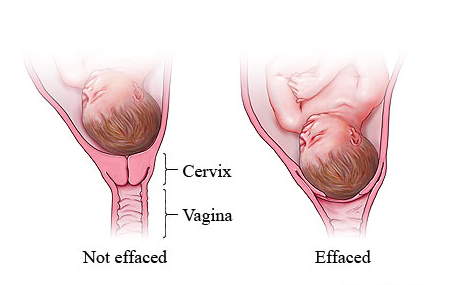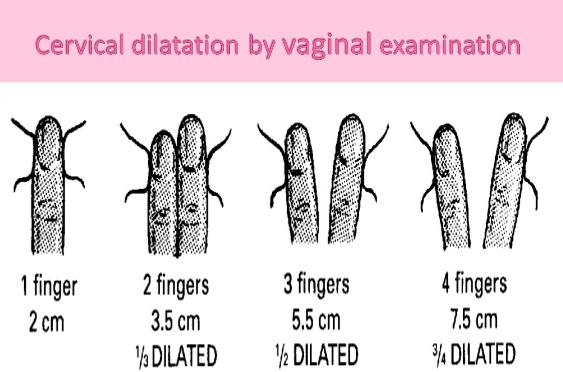If you’re not sure what “1 cm dilated 50 effaced” means you’re not alone. In fact, many first-time mothers and seasoned moms alike are unfamiliar with what this indicates in regards to labor. Somewhere close to week 37 of pregnancy doctors and sometimes midwives, will start checking your cervix for dilation and effacement. A little research can help you understand what’s going on at your next appointment when the doctor starts talking about dilation, effacement or station.
What Does “1 cm Dilated 50 Effaced” Mean?
When a woman labors, her cervix dilates to give room for the baby to move from the uterus through the vaginal canal. When labor first starts a woman may dilate up to 4 cm before entering the active stage. If you are 1 cm dilated and 50 % effaced it means your cervix is starting to move into position for birth, it’s thinning out and starting to open for your baby to move out. It doesn’t tell anyone when the baby will arrive, it just indicates the body is getting ready for labor. Some women will walk around like this for days or weeks while others only start to dilate when they are in labor.
Each woman will labor differently and each time she has a baby the process can be different still. There are women who will be 3 cm dilated and 70% effaced for a couple of weeks and then suddenly active labor will come about. Other women will have a cervix remain completely closed until labor begins. The best indication of labor is contractions that come on regularly, can be timed and do not go away with position changes or with hydration. Labor is unique. If you speak to three different women, they will all have had a different experience. And if they’ve had more than one child, they’ll tell you each labor was different.
What Is Effacement?

When not pregnant, a woman’s cervix is thick, long and closed. The actual measurements are between 3-5 centimeters. During the final weeks of pregnancy, the lower uterus gets ready for the baby and the cervix gets thinner and shorter. The term used for this is effacement. The more effaced the cervix is, the shorter it gets. The cervix will ‘pull up’ and almost disappear to blend into the lower part of the uterus. This is also referred to as thinning or ripening. The process generally takes a few weeks before the cervix becomes fully effaced.
In these last few weeks, your doctor will examine you to check for changes or progress. Effacement is measured in percentages, and that’s what the latter half of “1 cm dilated 50 effaced” indicate. Without any change, the cervix is described as 0% effaced, when it’s half its normal thickness then 50 %. It will continue on until the cervix becomes 100% effaced and then the baby can be birthed.
What Is Dilation?

To make it easier for the baby’s head and body to pass into the vaginal canal, the cervix thins out and effaces. This stretching and opening allows for the room needed for the baby to be birthed. This is called dilation. This process is measured in centimeters, as the first half of “1 cm dilated 50 effaced” indicate.
During the majority of your pregnancy the cervix will measure zero, that is to say it will be closed. This allows the baby to safely grow inside. You will generally be measured when you’re in active labor. Your healthcare provider will insert gloved fingers into your vagina to measure how dilated you are. For this reason, some examiners will refer to the measurement in ‘fingers’.
Labor is then measured by how the laboring mother is progressing and it is thought she should dilate a centimeter each hour of labor to be on track. It is important to note that this won’t be the same for every labor and every woman. The early labor stage occurs between 0-4 centimeters of dilation. Active labor is the term used when a woman is dilated between 4-7 centimeters. The final phase of labor, the transition phase, occurs between 7-10 centimeters. You are considered ready to start pushingwhen your cervix is dilated to 10 centimeters (fully dilated) which is nearly the size of a newborn’s head.
Braxton Hicks or Labor?
When a woman starts getting closer to labor, the baby’s head drops and contractions can begin. Cramping and pressure is caused by the effacing and dilating cervix. Some women, especially first time moms, will think this is active labor but it is called Braxton Hicks. Braxton Hicks is the term given to early contractions that help prepare the body for labor. Real labor has some differences including:
- Real contractions won’t go away. They continue when you drink water, are active or relaxing. Braxton Hicks stop, often from a change of activity or position or when you hydrate.
- When contractions are real they develop a pattern and come at regular intervals while Braxton Hicks are irregular.
- Braxton Hicks can be caused by dehydration.
Other Labor Signs You Need to Know
- Water Breaking- Unlike the movies portrayal, only about 10% of labors start with the woman’s amniotic sacbreaking. It’s also not always true that water breaking means active labor happens immediately, although most will within a day or two.
- Mucous Plug-This is what seals the cervix closed to help protect the baby and uterus from infection. Not all women will lose this as an early labor indication. Some women lose it during labor or near the end while others may not lose it at all. It can be lost in a large piece or in small pieces. If it is lost early it can also grow back.
- Bloody Show- If you use the restroom and blood appears when you wipe, this is considered bloody show. It is caused by capillaries in the cervix dilating with the cervix. This generally happens when the mucous plug is lost. If your bleeding is heavy or you need to wear a pad and change it often, then you should contact your doctor right away.
